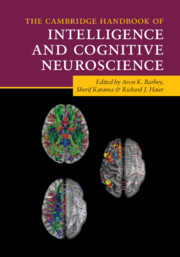Book contents
- The Cambridge Handbook of Intelligence and Cognitive Neuroscience
- Reviews
- The Cambridge Handbook of Intelligence and Cognitive Neuroscience
- Copyright page
- Dedication
- Contents
- Figures
- Tables
- Contributors
- Preface
- Part I Fundamental Issues
- Part II Theories, Models, and Hypotheses
- Part III Neuroimaging Methods and Findings
- Part IV Predictive Modeling Approaches
- Part V Translating Research on the Neuroscience of Intelligence into Action
- 18 Enhancing Cognition
- 19 Patient-Based Approaches to Understanding Intelligence and Problem-Solving
- 20 Implications of Biological Research on Intelligence for Education and Public Policy
- 21 Vertical and Horizontal Levels of Analysis in the Study of Human Intelligence
- 22 How Intelligence Research Can Inform Education and Public Policy
- 23 The Neural Representation of Concrete and Abstract Concepts
- Index
- References
22 - How Intelligence Research Can Inform Education and Public Policy
from Part V - Translating Research on the Neuroscience of Intelligence into Action
Published online by Cambridge University Press: 11 June 2021
- The Cambridge Handbook of Intelligence and Cognitive Neuroscience
- Reviews
- The Cambridge Handbook of Intelligence and Cognitive Neuroscience
- Copyright page
- Dedication
- Contents
- Figures
- Tables
- Contributors
- Preface
- Part I Fundamental Issues
- Part II Theories, Models, and Hypotheses
- Part III Neuroimaging Methods and Findings
- Part IV Predictive Modeling Approaches
- Part V Translating Research on the Neuroscience of Intelligence into Action
- 18 Enhancing Cognition
- 19 Patient-Based Approaches to Understanding Intelligence and Problem-Solving
- 20 Implications of Biological Research on Intelligence for Education and Public Policy
- 21 Vertical and Horizontal Levels of Analysis in the Study of Human Intelligence
- 22 How Intelligence Research Can Inform Education and Public Policy
- 23 The Neural Representation of Concrete and Abstract Concepts
- Index
- References
Summary
This chapter aims to explore how intelligence research – both current evidence as well as potential new findings that remain undiscovered – might inform education and public policy. We will first address why studying human intelligence is not only an exciting area of research for basic discovery, but also how knowledge about intelligence might be applicable to education and public policy. We will review selected areas of intelligence related research with potential implications for policy. We will discuss research on intelligence test scores as predictors of school performance and later success and research on features of the most promising policy relevant variables for improving intelligence. Finally, we will conclude with a discussion and explanation for researchers about how influencing policy requires (1) learning from policy researchers and practitioners, who have expertise that we argue complements the strengths of intelligence researchers and (2) effectively communicating those findings to policy researchers and practitioners. We write this chapter primarily from the perspective of researchers who are engaged in intelligence research that might be applied to education and policy discussions.
- Type
- Chapter
- Information
- Publisher: Cambridge University PressPrint publication year: 2021

